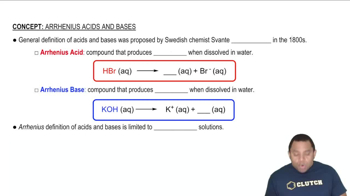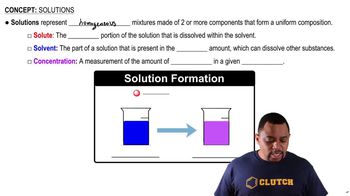In a titration experiment, 50.0 mL of 0.075 M acetic acid, CH3COOH, is titrated with the 0.250 M KOH(aq) that is in the burette. The drawing shows the level of the KOH in the burette before the titration begins. What will be the burette reading at the equivalence point?
State whether each of the following statements is true or false. Justify your answer in each case. (b) When ammonium nitrate, NH4NO3, dissolves in water, the solution is weakly conducting and basic in nature.
 Verified step by step guidance
Verified step by step guidanceKey Concepts
Dissociation of Ionic Compounds

Acid-Base Properties of Ions

Electrical Conductivity in Solutions

State whether each of the following statements is true or false. Justify your answer in each case. (a) Electrolyte solutions conduct electricity because electrons are moving through the solution.
State whether each of the following statements is true or false. Justify your answer in each case. (b) If you add a nonelectrolyte to an aqueous solution that already contains an electrolyte, the electrical conductivity will not change.
We have learned in this chapter that many ionic solids dissolve in water as strong electrolytes; that is, as separated ions in solution. Which statement is most correct about this process? (a) Water is a strong acid and therefore is good at dissolving ionic solids. (b) Water is good at solvating ions because the hydrogen and oxygen atoms in water molecules bear partial charges. (c) The hydrogen and oxygen bonds of water are easily broken by ionic solids.
Would you expect that an anion would be physically closer to the oxygen or to the hydrogens of water molecules that surround it in solution?
Specify what ions are present in solution upon dissolving each of the following substances in water: a. FeCl2
